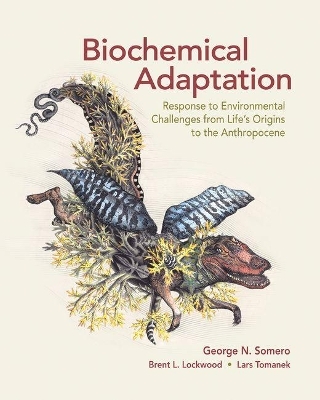
Biochemical Adaptation
Oxford University Press Inc (Verlag)
978-1-60535-564-1 (ISBN)
Published by Sinauer Associates, an imprint of Oxford University Press.
The abiotic characteristics of the environment--including temperature, oxygen availability, salinity, and hydrostatic pressure--present challenges to all biochemical structures and processes. This volume first examines the nature of these perturbations to biochemical systems and then elucidates the major adaptive strategies that enable organisms from all Domains of Life--Archaea, Bacteria, and Eukarya--to conserve common types of biochemical structures and processes across a wide range of environments. In addition to these conservative adaptations that foster a biochemical unity among diverse species, other adaptations can be viewed as innovative changes that enable organisms to exploit new features of the environment that may themselves be the result of biological activities.
The opening chapter outlines the basic principles of biochemical adaptations and raises the questions that serve as the focal points for the detailed analysis found in the next three chapters, which are devoted to the study of relationships involving oxygen, temperature, and water-solute effects. In these three chapters, the effects of the variable in question on fundamental biochemical processes and structures are examined. This analysis forms a basis for the subsequent analysis of how adaptive changes modify biochemical systems to establish environmental optima and tolerance limits. This analysis includes examples from all Domains of Life to emphasize the commonality of the fundamental strategies of biochemical adaptation.
The final chapter examines the challenges organisms face from the rapid environmental changes that are occurring in the Anthropocene. The effects of co-occurring changes in multiple stressors are examined to provide a realistic and integrative analysis of effects of global change. The underlying genetic capacities of different types of organisms to adapt to rapid environmental change are discussed to provide a basis for predicting the relative success different species--including our own--face in a rapidly changing world.
George N. Somero is David and Lucile Packard Emeritus Professor of Marine Sciences at the Hopkins Marine Station of Stanford University. After receiving a Bachelor's Degree in Biology from Carleton College, he completed his Ph.D. in Biological Sciences at Stanford (with Dr. Arthur Giese), and postdoctoral studies with Dr. Peter Hochachka at the University of British Columbia. Dr. Somero coauthored three books on biochemical adaptation with Dr. Hochachka, and coedited (with Charles B. Osmond and Carla L. Bolis) Water and Life, a volume on water-solute relationships. His major research interests focus on the effects of abiotic environmental factors (especially temperature, salinity, oxygen availability, and hydrostatic pressure) on biochemical systems. Brent L. Lockwood is Assistant Professor of Biology at the University of Vermont. He received Bachelor's Degrees in Biology and Anthropology from the University of California, San Diego and completed his Ph.D. in Biological Sciences in the lab of Dr. George Somero at Stanford University. Dr. Lockwood was an NIH postdoctoral fellow in the lab of Dr. Kristi Montooth at Indiana University. His lab works at the interface of physiology and evolutionary biology to elucidate the mechanisms that constrain or facilitate adaptation to environmental change. Lars Tomanek is Associate Professor of Department of Biological Sciences at California Polytechnic State University. He received his Bachelor's and Master's Degrees in Biology from the University of Konstanz (Germany). He completed his Ph.D. with Dr. George Somero at Oregon State University, and he did postdoctoral work with Dr. Somero at Stanford University and Dr. Dietmar Kültz at the University of California, Davis. Working mainly with intertidal invertebrates, he and his students integrate across levels of biological organization, from the subcellular to the whole-organism, to study physiological responses to temperature, osmotic, pH, hypoxic, heavy metal, and endocrine stressors.
Chapter 1: A Conceptual Foundation for Understanding Biochemical Adaptation.- Chapter 2: Oxygen and Metabolism.- Chapter 3: Temperature.- Chapter 4: Water and Solutes: Evolution and Regulation of Biological Solutions.- Chapter 5: Adaptation in the Anthropocene.
| Erscheinungsdatum | 30.12.2016 |
|---|---|
| Verlagsort | New York |
| Sprache | englisch |
| Maße | 259 x 206 mm |
| Gewicht | 1599 g |
| Themenwelt | Geisteswissenschaften ► Sprach- / Literaturwissenschaft ► Sprachwissenschaft |
| Studium ► 1. Studienabschnitt (Vorklinik) ► Physiologie | |
| Naturwissenschaften ► Biologie ► Biochemie | |
| Naturwissenschaften ► Biologie ► Evolution | |
| Naturwissenschaften ► Biologie ► Ökologie / Naturschutz | |
| Naturwissenschaften ► Biologie ► Zoologie | |
| ISBN-10 | 1-60535-564-X / 160535564X |
| ISBN-13 | 978-1-60535-564-1 / 9781605355641 |
| Zustand | Neuware |
| Haben Sie eine Frage zum Produkt? |
aus dem Bereich


